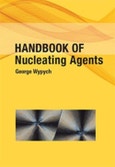Handbook of Nucleating Agents gives information on how to increase the production rate, modify structure and morphology, improve mechanical performance, and reduce haze of polymeric products with a proper selection of nucleating agents (and/or the so-called clarifying agents). Handbook of Nucleating Agents brings analyses of important publications found in open and patent literature. Special attention is given to the findings of the last five years which brought many new important developments.
The book is divided into 14 chapters each of which concentrates on essential performance of nucleating agents. Chemical origin and related properties of nucleating agents are analyzed in general terms to highlight the differences in their properties. The specific agents are discussed in Databook of Nucleating Agents which is published as a separate book to help in selection of product available in the commercial markets and analyze properties of different products. Information in Databook and Handbook is totally different without any repetition.
The next six chapters of Handbook discuss the most essential theoretical knowledge required for the proper selection and use of nucleating and clarifying agents. These include polymer crystallization in the presence and without nucleating agents, parameters of crystallization, essential influences on the nucleation processes, the measures of nucleation efficiency, the mechanisms of nucleation, and the effective methods of dispersion of nucleating agents.
Following three chapters concentrate on the application aspects in different formulations. Here extensive use is being made of patent literature and research papers available for different applications. Discussed are 19 polymer processing methods which require use of nucleating agents, 40 different polymers which are known to use nucleating agents, and 16 groups of commercial products in which nucleating agents found applications. This shows that the modern use nucleating agent is widespread in industry.
The last three chapters discuss the effects of nucleating agents on physical and mechanical properties of materials, the most essential analytical techniques used to analyze systems containing nucleating agents, and health and safety in use of nucleating agents.
This important and timely publication(s) should not be missed. They contain essential information for upgrading production to the more economical level and products to the highest performance standards possible today.
Table of Contents
1 Introduction2 Chemical Origin of Nucleating Agents
2.1 Acids
2.2 Amides
2.3 Carbon nanotubes
2.4 Graphene derivatives
2.5 Hydrazides
2.6 Inorganic materials
2.6.1 Boron nitride
2.6.2 Calcium carbonate
2.6.3 Hydroxides
2.6.4 Silica
2.6.5 Talc
2.6.6 Others
2.7 Masterbatch
2.8 Phosphate salts
2.9 Polymeric
2.10 Proprietary nucleating agents
2.11 Salts of carboxylic acids
2.12 Sorbitol derivatives
2.13 Xylan esters
2.14 Other nucleating agents
3 Polymer Crystallization with and without Nucleating Agents
4 Parameters of Crystallization
5 What Influences Nucleation?
5.1 Concentration
5.2 Solubility of nucleating agent in polymer
5.3 Shear rate and time
5.4 Form of nucleating agent
5.5 Mixtures of nucleating agents
6 Nucleation Efficiency Measures
6.1 Nuclei density
6.2 Nucleation activity and constant
6.3 Nucleation efficiency
6.4 Activation energy
7 Mechanisms of Crystallization
8 Dispersion of Nucleating Agents
9 Nucleating Agents in Different Processing Methods
9.1 Blow molding
9.2 Blown film extrusion
9.3 Calendering
9.4 Compression molding
9.5 Dip coating
9.6 Extrusion
9.7 Foaming
9.8 Hot-melt coating
9.9 Injection molding
9.10 Micro-injection molding
9.11 Powder injection molding
9.12 Pultrusion
9.13 Reaction injection molding
9.14 Rotational molding
9.15 Sheet molding
9.16 Spinning
9.17 Thermoforming
9.18 Welding and machining
9.19 Wire coating
10 Application of Nucleating Agents in Specific Polymers
10.1 Poly(acrylonitrile-co-butadiene-co-styrene)
10.2 Cellulose acetate
10.3 Epoxy resin
10.4 Ethylene-propylene diene terpolymer
10.5 Ethylene-vinyl acetate copolymer
10.6 Fluorinated ethylene-propylene copolymer
10.7 Liquid crystalline polymer
10.8 Polyamide
10.9 Poly(acrylic acid)
10.10 Polyacrylonitrile
10.11 Polyaniline
10.12 Poly(butylene terephthalate)
10.13 Polycarbonate
10.14 Poly(?-caprolactone)
10.15 Polychlorotrifluoroethylene
10.16 Polyethylene
10.17 Polyetheretherketone
10.18 Polyetherketoneketone
10.19 Poly(ethylene oxide)
10.20 Poly(ether sulfone)
10.21 Poly(ethylene terephthalate)
10.22 Polyethylene, silane-crosslinkable
10.23 Poly(glycolic acid)
10.24 Poly(3-hydroxybutyrate)
10.25 Poly(3-hydroxybutyrate-co-3-hydroxyvalerate)
10.26 Polyimide
10.27 Poly(lactic acid)
10.28 Polyoxymethylene
10.29 Polypropylene
10.30 Polyphthalamide
10.31 Poly(p-phenylene sulfide)
10.32 Polystyrene
10.33 Poly(trimethylene terephthalate)
10.34 Polyurethane
10.35 Poly(vinyl alcohol)
10.36 Poly(vinylidene fluoride)
10.37 Poly(vinylidene fluoride-co-hexafluoropropylene)
10.38 Poly(vinyl fluoride)
10.39 Poly(N-vinyl carbazole)
10.40 Unsaturated polyester
11 Nucleating Agents in Various Products
11.1 Adhesives
11.2 Aerospace
11.3 Appliances
11.4 Automotive materials
11.5 Bottles
11.6 Building construction
11.7 Cable & wire
11.8 Coatings & paints
11.9 Electronics and electrical
11.10 Fibers
11.11 Films
11.12 Medical applications
11.13 Pharmaceutical applications
11.14 Railway
11.15 Roofing
11.16 Window profiles
12 Effect of Nucleating Agents on Physical-mechanical Properties
12.1 Physical properties
12.1.1 Agglomeration
12.1.2 Aspect ratio
12.1.3 Crystalline structure
12.1.4 Hydrophilic/hydrophobic properties
12.1.5 Melting temperature
12.1.6 Moisture
12.1.7 Optical properties
12.1.8 Particle size
12.1.9 Refractive index
12.1.10 Shape memory
12.1.11 Solubility
12.1.12 Surface energy
12.1.13 Thermal conductivity
12.1.14 Transition temperature
12.1.15 Zeta potential
12.2 Mechanical properties
12.2.1 Flexural strength
12.2.2 Hardness
12.2.3 Impact strength
12.2.4 Residual stress
12.2.5 Scratch resistance
12.2.6 Shrinkage
12.2.7 Tear strength
12.2.8 Thermal deformation
12.2.9 Tensile strength
13 Important Analytical Methods Used in the Studies of Nucleating Agents
13.1 Crystallinity
13.2 Crystallization half-time
13.3 Differential scanning calorimetry
13.4 Fast scanning chip calorimetry
13.5 FTIR
13.6 Haze
13.7 Orientation degree
13.8 Polarized light microscopy
13.9 Quenching device
13.10 Small angle x-ray diffraction
13.11 Spherulite size
13.12 Thermogravimetric analysis
13.13 Vicat softening temperature
13.14 Wide angle x-ray diffraction
14 Health and Safety with Nucleating Agents
Index








